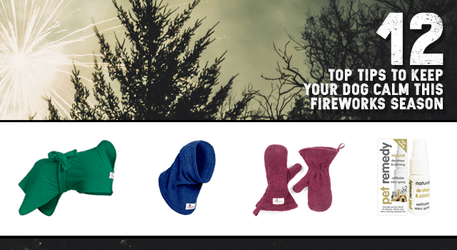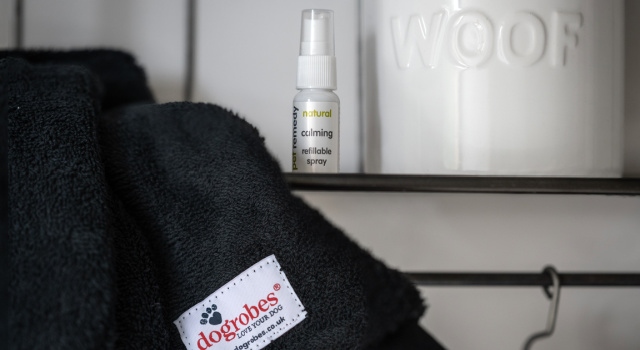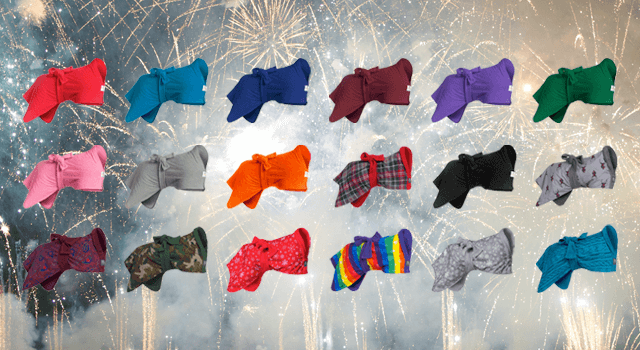12 Top tips for keeping your dog calm this fireworks season
Oct 23, 2022
It's nearly that time of year again – fireworks night, an anxious time of year for many dog owners. We’re here to help…
Why do fireworks make some dogs anxious?
Fireworks can be frightening for our dogs because of the flashing lights, loud bangs and the strong smell of spent explosives. Dogs are well-known for having a strong sense of smell but their hearing is incredible too. They can hear sounds that are four times further away than a human. Dog's ears can also detect much higher frequencies than we can too. So, even if we can tolerate the noise, it may be very uncomfortable for our dogs.
Is it normal for dogs to be frightened by fireworks?
It’s natural for a dog to be wary of loud noises, especially if they’re unsure of where the noise is coming from or what it is. Loud noises can trigger a fight-or-flight response in dogs because of their inbuilt survival instincts.
According to the Kennel Club, 48% of dog owners say their dogs are scared by fireworks and there’s a 100% increase in dogs going missing during fireworks season.
Their research shows that eight in ten owners notice significant changes in their dog’s behaviour during fireworks' season. Almost a third say their dog shivers and trembles and more than a quarter mention unusual, excessive barking. Other behavioural changes are either the dog becoming extra clingy or the opposite, dogs hiding under various surfaces and avoiding contact.
We caught up with Andrew Hale, a Certified Animal Behaviourist with our friends at Pet Remedy and asked what we can do to make our dogs feel less anxious during fireworks season.
What are your top tips for keeping dogs calm on Fireworks Night?
1. Create a safe hiding place
Your dog will want to sit in a place where he feels safe. This may be under the sofa or in a crate. You can also cover your dog’s crate with a duvet to try to soundproof it and dull the noise from outside. But if your dog's safe place is upstairs in a bedroom and this is normally out of bounds, throw that rule away for the night, and allow your dog to feel that safety. It doesn’t give them carte blanche to keep doing it, but as a one-off, it really won’t hurt.
2. Feed your dog before the fireworks begin
Feed your dog before you expect the fireworks to begin as they may not eat if they’re anxious. Make sure your dog has enough water too, as anxious dogs pant more and become thirsty.
3. Daytime walks only
Make sure you only take your dog out in daylight and any night walks you normally do, get taken earlier. Changing your routine is a simple thing but it can make all the difference.
4. The power of touch
A soothing and reassuring stroke of your dog can do wonders to make them feel calm. In my experience, sometimes a dog responds better to being stroked if you are wearing Gauntlets. This is because it is a softer and warmer feel for the dog compared to a bare hand. You can use them later too, for a quick rub down of your dog when a full on Dogrobe isn’t needed.
5. Stay calm
Keep calm and this will send positive signals to your dog. Try to act and behave as normal as your dog will pick up on any unusual behaviour.
6. Soothing smells
A drop of Pet Remedy is brilliant to ease the anxiety and panic of a dog. But don’t just use it for the first time on the night. Introduce it prior to the evening, just spraying a few drops on a bit of rag to get your dog familiar with it. Dogrobes now stock Pet Remedy Mini Calming Spray. Just click on the link and add it to your basket.
This is where a Snood comes in useful too as you can get your dog warm and cosy in a Snood and spray a little Pet Remedy on that. It also helps to block out the noise.
Again, prepare your dog for wearing the Snood, as some dogs may take time to get used to it. My suggestion would be to gently get your dog to lean through the Snood, offering a treat as they do so. When your dog is comfortable wearing the Snood put a drop of Pet Remedy onto the Snood fabric and the calming smell, along with the Snood, will feel familiar and comforting.
Snoods are available in 9 sizes and 10 colours. Dogrobes recommend dropping down a size from your Dogrobe size for a snug fit, unless your dog wears a Toy or Mini Dogrobe. For those sizes, stick to the same size as the Dogrobe you have.
7. Make it loud
Keep a TV or radio on or play your usual music a bit louder. This will reduce the impact of sudden bangs. Pet Classics is a special programme to calm pets on Bonfire Night. Charlotte Hawkins is the host and it will be broadcast on Friday 4th and Saturday 5th November from 5pm to 9pm, on Classic FM.
There are lots of playlists available to keep your dog calm too. Here are some of our favourites:
As long as you are keeping the house at a noisier level then your dog won’t be so aware of the bangs outside.
8. Block out the outside
Shut all doors and windows and keep your blinds and curtains closed to block out the flashing lights.
9. Use your Dogrobe
It’s on occasions like these you realise just how versatile 3-in-1 Dogrobes really are. They not only dry and warm your dog, they also comfort them. There are countless examples of where the Dogrobe has helped calm nervous or anxious dogs when used as a comfort coat, which is perfect for fireworks night.
Dogrobes' vet, Dr Ciara Clarke explains the theory behind this concept:
"Gentle pressure around a dog's chest acts like soothing swaddling, reducing anxiety. The Dogrobe, should be wrapped and tied closely around the dog's torso creating a constant but gentle pressure, creating an overall calming effect. The Dogrobe can stay like this on the dog for up to 2-3 hours."
Dogrobes are available in a size and colour to suit every dog. Check out the Size Guide for a Chihuahua up to a Newfoundland. There are lots of vibrant colours and patterns to choose from. There's even Made To Measure.
10. Collars on
Did you know that more dogs are lost during bonfire season than at any other time of the year? With this in mind, we suggest making sure your dog has its collar and tag on just in case. Always make sure you have your dog’s microchip details too. If someone knocks at the door, keep your dog in a secure room whilst you see who it is.
11. Chocolate is off the menu
As we all know, chocolate can be very dangerous for dogs. If eaten it can cause vomiting, diarrhoea, rapid breathing, increased heart rate and seizures. Sweets containing xylitol (an artificial sweetener) are no better either, causing a drop in blood sugar, loss of coordination and seizures. So, make sure any trick or treat sweets are out of reach in cupboards.
12. Be careful of lit pumpkins
Although they look good, a lit pumpkin could end in disaster if your dog was to get too close and burn themselves or knock it over resulting in a fire. Although nontoxic, if too many pumpkin seeds are eaten, they can cause an upset stomach.
What can you do to help regulate fireworks?
With continued calls to local councils to stop people from being able to buy fireworks without a license, bangs in back gardens could become a thing of the past. Limiting fireworks to displays only, would have a positive impact on reducing the stress of the night on our four-legged friends.
The RSPCA's campaign #Bangoutoforder is calling for tighter regulations of fireworks and considerations of others. They would like to see the UK governments following Scotland's lead and introduce legislation to :
- limit the sale of fireworks
- introduce firework control zones
- introduce a licensing system for the purchase and sale of fireworks by and to members of the public
- reduce the maximum permitted noise level
They're asking pet owners to get in touch and share their experiences of how fireworks affect their pets. The RSPCA also recommend that you get in touch with your local MP to ask them to take action on fireworks.
Here’s hoping we can get to the stage where the unpredictability of fireworks is stopped right across the UK.
With thanks to Andrew Hale, animal behaviourist at Pet Remedy for his help in creating this article:

7. Make it loud
Keep a TV or radio on or play your usual music a bit louder. This will reduce the impact of sudden bangs. Pet Classics is a special programme to calm pets on Bonfire Night. Charlotte Hawkins is the host and it will be broadcast on Friday 4th and Saturday 5th November from 5pm to 9pm, on Classic FM.
There are lots of playlists available to keep your dog calm too. Here are some of our favourites:
As long as you are keeping the house at a noisier level then your dog won’t be so aware of the bangs outside.
8. Block out the outside
Shut all doors and windows and keep your blinds and curtains closed to block out the flashing lights.
9. Use your Dogrobe
It’s on occasions like these you realise just how versatile 3-in-1 Dogrobes really are. They not only dry and warm your dog, they also comfort them. There are countless examples of where the Dogrobe has helped calm nervous or anxious dogs when used as a comfort coat, which is perfect for fireworks night.
Dogrobes' vet, Dr Ciara Clarke explains the theory behind this concept:
"Gentle pressure around a dog's chest acts like soothing swaddling, reducing anxiety. The Dogrobe, should be wrapped and tied closely around the dog's torso creating a constant but gentle pressure, creating an overall calming effect. The Dogrobe can stay like this on the dog for up to 2-3 hours."
Dogrobes are available in a size and colour to suit every dog. Check out the Size Guide for a Chihuahua up to a Newfoundland. There are lots of vibrant colours and patterns to choose from. There's even Made To Measure.
10. Collars on
Did you know that more dogs are lost during bonfire season than at any other time of the year? With this in mind, we suggest making sure your dog has its collar and tag on just in case. Always make sure you have your dog’s microchip details too. If someone knocks at the door, keep your dog in a secure room whilst you see who it is.
11. Chocolate is off the menu
As we all know, chocolate can be very dangerous for dogs. If eaten it can cause vomiting, diarrhoea, rapid breathing, increased heart rate and seizures. Sweets containing xylitol (an artificial sweetener) are no better either, causing a drop in blood sugar, loss of coordination and seizures. So, make sure any trick or treat sweets are out of reach in cupboards.
12. Be careful of lit pumpkins
Although they look good, a lit pumpkin could end in disaster if your dog was to get too close and burn themselves or knock it over resulting in a fire. Although nontoxic, if too many pumpkin seeds are eaten, they can cause an upset stomach.
What can you do to help regulate fireworks?
With continued calls to local councils to stop people from being able to buy fireworks without a license, bangs in back gardens could become a thing of the past. Limiting fireworks to displays only, would have a positive impact on reducing the stress of the night on our four-legged friends.
The RSPCA's campaign #Bangoutoforder is calling for tighter regulations of fireworks and considerations of others. They would like to see the UK governments following Scotland's lead and introduce legislation to :
- limit the sale of fireworks
- introduce firework control zones
- introduce a licensing system for the purchase and sale of fireworks by and to members of the public
- reduce the maximum permitted noise level
They're asking pet owners to get in touch and share their experiences of how fireworks affect their pets. The RSPCA also recommend that you get in touch with your local MP to ask them to take action on fireworks.
Here’s hoping we can get to the stage where the unpredictability of fireworks is stopped right across the UK.
With thanks to Andrew Hale, animal behaviourist at Pet Remedy for his help in creating this article:








